Destination Analysis Report (DAR)
VerifiedAdded on 2023/02/01
|10
|3333
|27
AI Summary
This report provides a critical analysis of Hong Kong as a tourist destination, including the role of the DMO, marketing campaigns, risks, and competitiveness. It discusses the overview, location, key tourist markets, tourism products, and tourist segments of Hong Kong. The report also highlights the future strategies and risks faced by the destination.
Contribute Materials
Your contribution can guide someone’s learning journey. Share your
documents today.
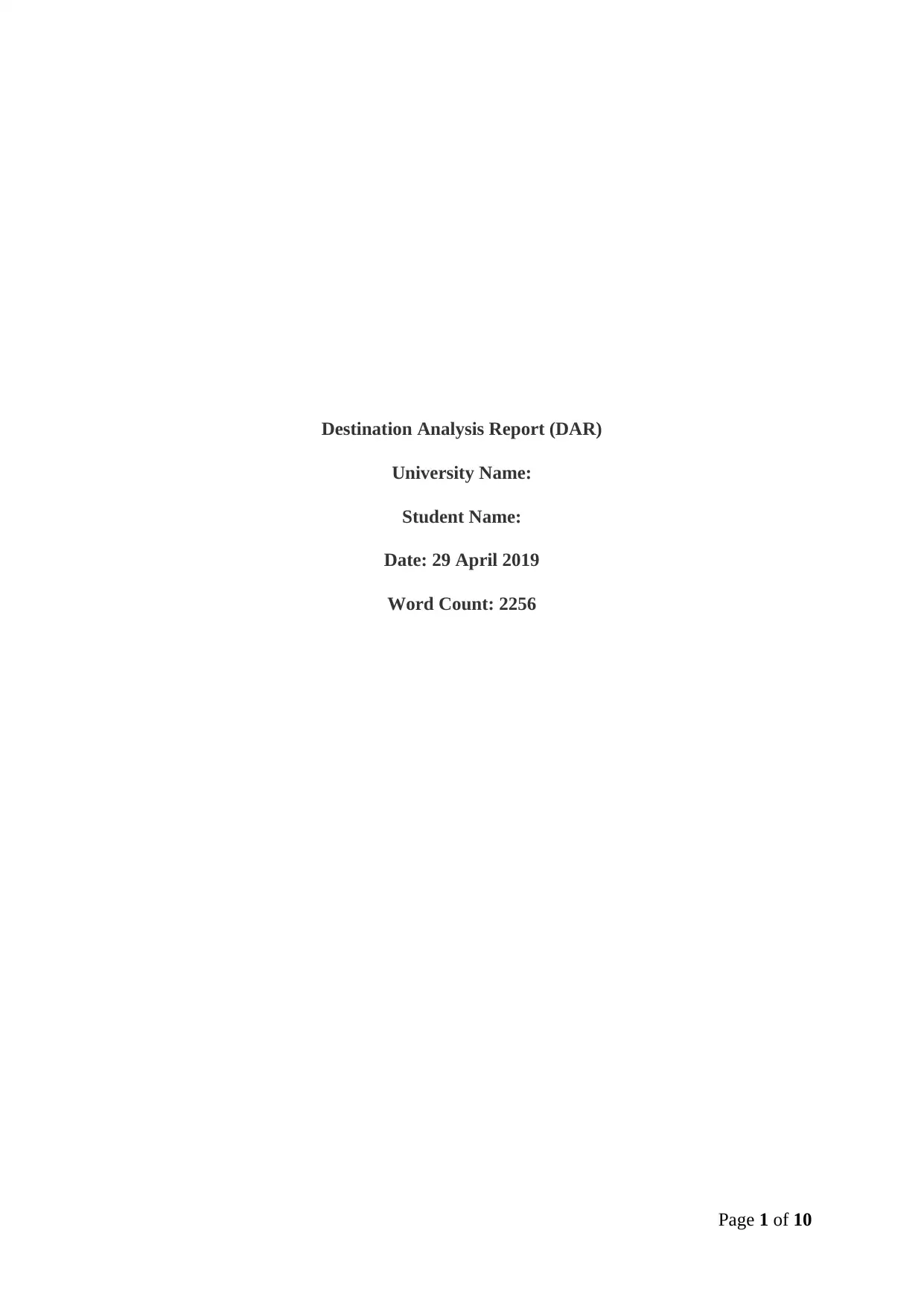
Destination Analysis Report (DAR)
University Name:
Student Name:
Date: 29 April 2019
Word Count: 2256
Page 1 of 10
University Name:
Student Name:
Date: 29 April 2019
Word Count: 2256
Page 1 of 10
Secure Best Marks with AI Grader
Need help grading? Try our AI Grader for instant feedback on your assignments.
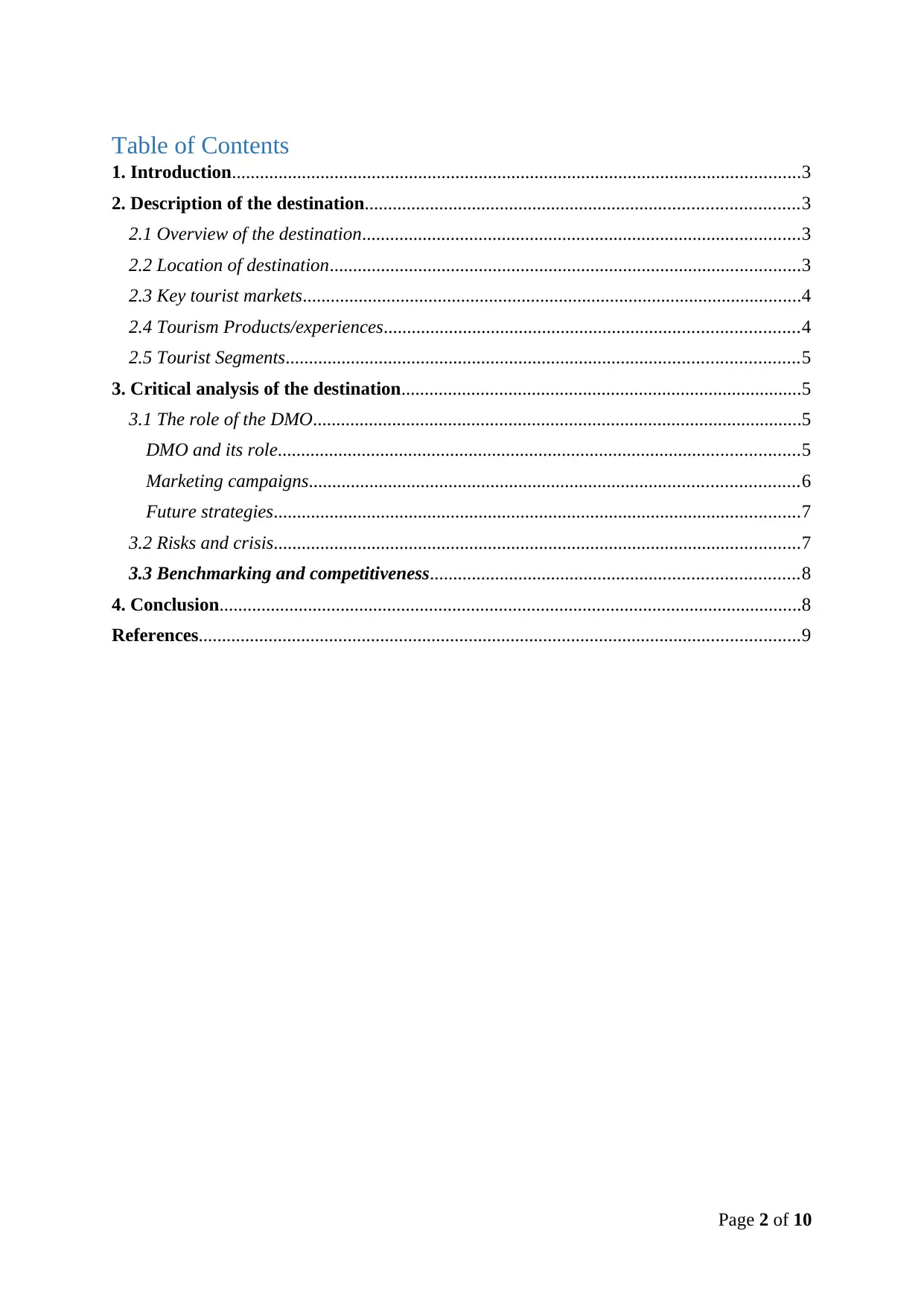
Table of Contents
1. Introduction..........................................................................................................................3
2. Description of the destination.............................................................................................3
2.1 Overview of the destination..............................................................................................3
2.2 Location of destination.....................................................................................................3
2.3 Key tourist markets...........................................................................................................4
2.4 Tourism Products/experiences.........................................................................................4
2.5 Tourist Segments..............................................................................................................5
3. Critical analysis of the destination......................................................................................5
3.1 The role of the DMO.........................................................................................................5
DMO and its role................................................................................................................5
Marketing campaigns.........................................................................................................6
Future strategies.................................................................................................................7
3.2 Risks and crisis.................................................................................................................7
3.3 Benchmarking and competitiveness...............................................................................8
4. Conclusion.............................................................................................................................8
References.................................................................................................................................9
Page 2 of 10
1. Introduction..........................................................................................................................3
2. Description of the destination.............................................................................................3
2.1 Overview of the destination..............................................................................................3
2.2 Location of destination.....................................................................................................3
2.3 Key tourist markets...........................................................................................................4
2.4 Tourism Products/experiences.........................................................................................4
2.5 Tourist Segments..............................................................................................................5
3. Critical analysis of the destination......................................................................................5
3.1 The role of the DMO.........................................................................................................5
DMO and its role................................................................................................................5
Marketing campaigns.........................................................................................................6
Future strategies.................................................................................................................7
3.2 Risks and crisis.................................................................................................................7
3.3 Benchmarking and competitiveness...............................................................................8
4. Conclusion.............................................................................................................................8
References.................................................................................................................................9
Page 2 of 10
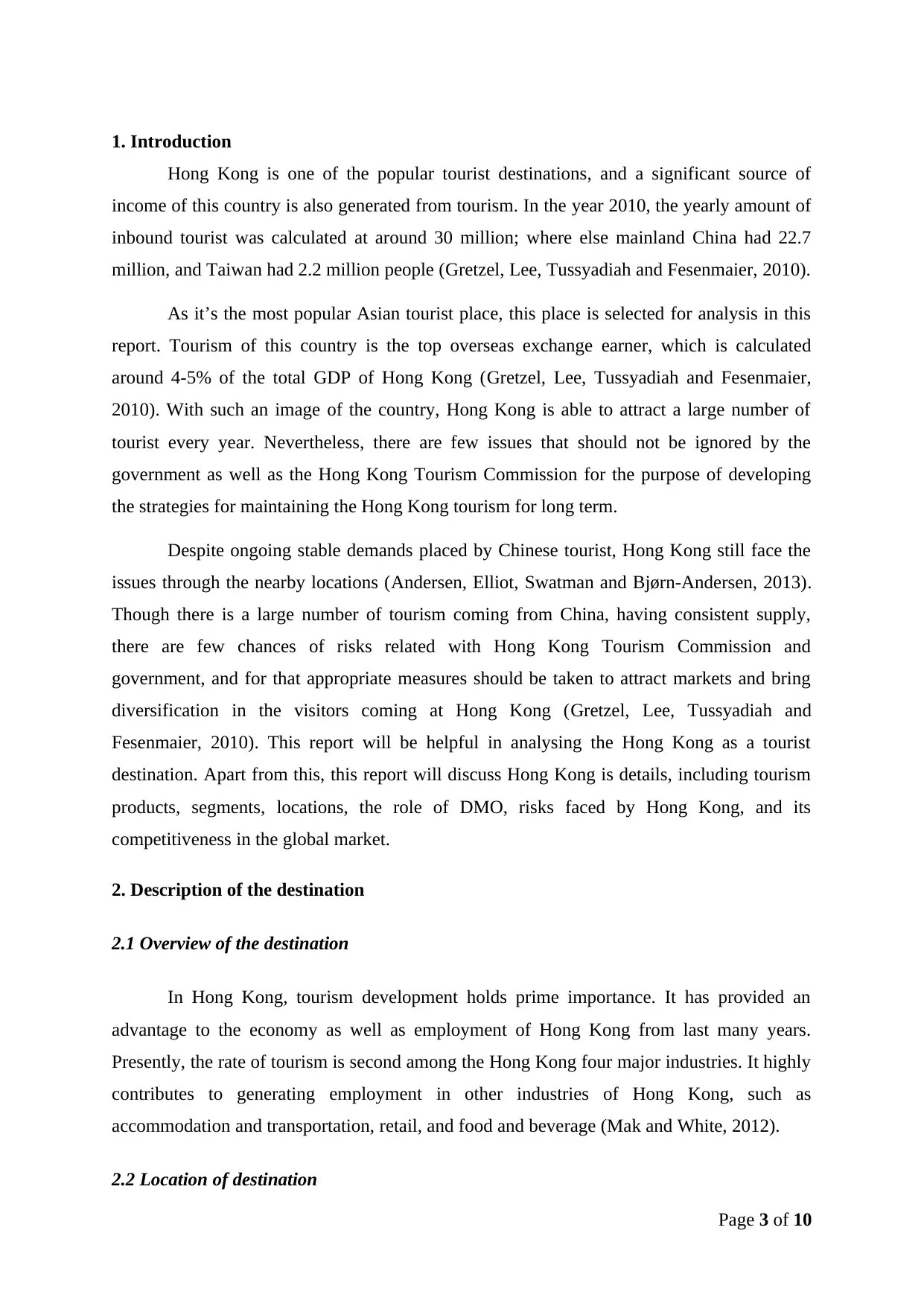
1. Introduction
Hong Kong is one of the popular tourist destinations, and a significant source of
income of this country is also generated from tourism. In the year 2010, the yearly amount of
inbound tourist was calculated at around 30 million; where else mainland China had 22.7
million, and Taiwan had 2.2 million people (Gretzel, Lee, Tussyadiah and Fesenmaier, 2010).
As it’s the most popular Asian tourist place, this place is selected for analysis in this
report. Tourism of this country is the top overseas exchange earner, which is calculated
around 4-5% of the total GDP of Hong Kong (Gretzel, Lee, Tussyadiah and Fesenmaier,
2010). With such an image of the country, Hong Kong is able to attract a large number of
tourist every year. Nevertheless, there are few issues that should not be ignored by the
government as well as the Hong Kong Tourism Commission for the purpose of developing
the strategies for maintaining the Hong Kong tourism for long term.
Despite ongoing stable demands placed by Chinese tourist, Hong Kong still face the
issues through the nearby locations (Andersen, Elliot, Swatman and Bjørn-Andersen, 2013).
Though there is a large number of tourism coming from China, having consistent supply,
there are few chances of risks related with Hong Kong Tourism Commission and
government, and for that appropriate measures should be taken to attract markets and bring
diversification in the visitors coming at Hong Kong (Gretzel, Lee, Tussyadiah and
Fesenmaier, 2010). This report will be helpful in analysing the Hong Kong as a tourist
destination. Apart from this, this report will discuss Hong Kong is details, including tourism
products, segments, locations, the role of DMO, risks faced by Hong Kong, and its
competitiveness in the global market.
2. Description of the destination
2.1 Overview of the destination
In Hong Kong, tourism development holds prime importance. It has provided an
advantage to the economy as well as employment of Hong Kong from last many years.
Presently, the rate of tourism is second among the Hong Kong four major industries. It highly
contributes to generating employment in other industries of Hong Kong, such as
accommodation and transportation, retail, and food and beverage (Mak and White, 2012).
2.2 Location of destination
Page 3 of 10
Hong Kong is one of the popular tourist destinations, and a significant source of
income of this country is also generated from tourism. In the year 2010, the yearly amount of
inbound tourist was calculated at around 30 million; where else mainland China had 22.7
million, and Taiwan had 2.2 million people (Gretzel, Lee, Tussyadiah and Fesenmaier, 2010).
As it’s the most popular Asian tourist place, this place is selected for analysis in this
report. Tourism of this country is the top overseas exchange earner, which is calculated
around 4-5% of the total GDP of Hong Kong (Gretzel, Lee, Tussyadiah and Fesenmaier,
2010). With such an image of the country, Hong Kong is able to attract a large number of
tourist every year. Nevertheless, there are few issues that should not be ignored by the
government as well as the Hong Kong Tourism Commission for the purpose of developing
the strategies for maintaining the Hong Kong tourism for long term.
Despite ongoing stable demands placed by Chinese tourist, Hong Kong still face the
issues through the nearby locations (Andersen, Elliot, Swatman and Bjørn-Andersen, 2013).
Though there is a large number of tourism coming from China, having consistent supply,
there are few chances of risks related with Hong Kong Tourism Commission and
government, and for that appropriate measures should be taken to attract markets and bring
diversification in the visitors coming at Hong Kong (Gretzel, Lee, Tussyadiah and
Fesenmaier, 2010). This report will be helpful in analysing the Hong Kong as a tourist
destination. Apart from this, this report will discuss Hong Kong is details, including tourism
products, segments, locations, the role of DMO, risks faced by Hong Kong, and its
competitiveness in the global market.
2. Description of the destination
2.1 Overview of the destination
In Hong Kong, tourism development holds prime importance. It has provided an
advantage to the economy as well as employment of Hong Kong from last many years.
Presently, the rate of tourism is second among the Hong Kong four major industries. It highly
contributes to generating employment in other industries of Hong Kong, such as
accommodation and transportation, retail, and food and beverage (Mak and White, 2012).
2.2 Location of destination
Page 3 of 10

Hong Kong is situated at the South Coast of China, which is around 60 km from the
east of Macau over the Pearl River Delta located on the opposite side and Shenzhen is at
North side (Gallarza, Saura and Garcia, 2012).
2.3 Key tourist markets
Hong Kong tourism market is highly abundant. It fulfil the expectation of most of the
people travelling there, which includes heritage places located over there, such as Tai O, Fu
Shin Street Traditional Bazaar, Po Lin Monastery, Man Mo Temple, Tien Buddha Statue, and
Temple of Ten Thousand Buddha’s, along with many museums, colourful architecture,
churches, theme parks and natural sites (Gursoy and McCleary, 2014). The Hong Kong
charm for the women is shopping, and Disneyland is the charm for children, which is located
in Hong Kong.
2.4 Tourism Products/experiences
Accommodation
In Hong Kong, there are around 50,000 rooms, and most of the accommodations are
connected with the system of public transport to make sure that every attraction is located
nearby (Hong Kong Trade Development Council-1, 2012). There are five types of hotels in
Hong Kong, such as five-star hotels, four-star hotels, budget hotel, three-star hotels, as well
as a boutique hotel. Five-star hotels usually provide luxurious premises, which includes
exercise, sports and swimming pool facilities to their guests (Hong Kong Trade Development
Council-1, 2012). In Four-star hotels, few facilities get reduced, but 24-hour room service,
showers and individual phones facilities are always provided.
Transportation
Hong Kong offered a huge level of transportation to meet the demand for transport;
therefore the transportation network of Hong Kong is adequately developed (Hong Kong
Trade Development Council-1, 2012). The Transit railways of Hong Kong is a convenient
manner for analysing how to visit the place that tourist want to go. There are around ten lines
included in the MTR system, including 83 railways stations, as well as 68 stops of light rail.
In Hong Kong, bus services hold a long history, and buses go everywhere (Hong Kong Trade
Development Council-1, 2012). There are different non-franchised services of public buses,
which cover up feeder bus service to railways systems that work as per the guidelines of
Page 4 of 10
east of Macau over the Pearl River Delta located on the opposite side and Shenzhen is at
North side (Gallarza, Saura and Garcia, 2012).
2.3 Key tourist markets
Hong Kong tourism market is highly abundant. It fulfil the expectation of most of the
people travelling there, which includes heritage places located over there, such as Tai O, Fu
Shin Street Traditional Bazaar, Po Lin Monastery, Man Mo Temple, Tien Buddha Statue, and
Temple of Ten Thousand Buddha’s, along with many museums, colourful architecture,
churches, theme parks and natural sites (Gursoy and McCleary, 2014). The Hong Kong
charm for the women is shopping, and Disneyland is the charm for children, which is located
in Hong Kong.
2.4 Tourism Products/experiences
Accommodation
In Hong Kong, there are around 50,000 rooms, and most of the accommodations are
connected with the system of public transport to make sure that every attraction is located
nearby (Hong Kong Trade Development Council-1, 2012). There are five types of hotels in
Hong Kong, such as five-star hotels, four-star hotels, budget hotel, three-star hotels, as well
as a boutique hotel. Five-star hotels usually provide luxurious premises, which includes
exercise, sports and swimming pool facilities to their guests (Hong Kong Trade Development
Council-1, 2012). In Four-star hotels, few facilities get reduced, but 24-hour room service,
showers and individual phones facilities are always provided.
Transportation
Hong Kong offered a huge level of transportation to meet the demand for transport;
therefore the transportation network of Hong Kong is adequately developed (Hong Kong
Trade Development Council-1, 2012). The Transit railways of Hong Kong is a convenient
manner for analysing how to visit the place that tourist want to go. There are around ten lines
included in the MTR system, including 83 railways stations, as well as 68 stops of light rail.
In Hong Kong, bus services hold a long history, and buses go everywhere (Hong Kong Trade
Development Council-1, 2012). There are different non-franchised services of public buses,
which cover up feeder bus service to railways systems that work as per the guidelines of
Page 4 of 10
Secure Best Marks with AI Grader
Need help grading? Try our AI Grader for instant feedback on your assignments.
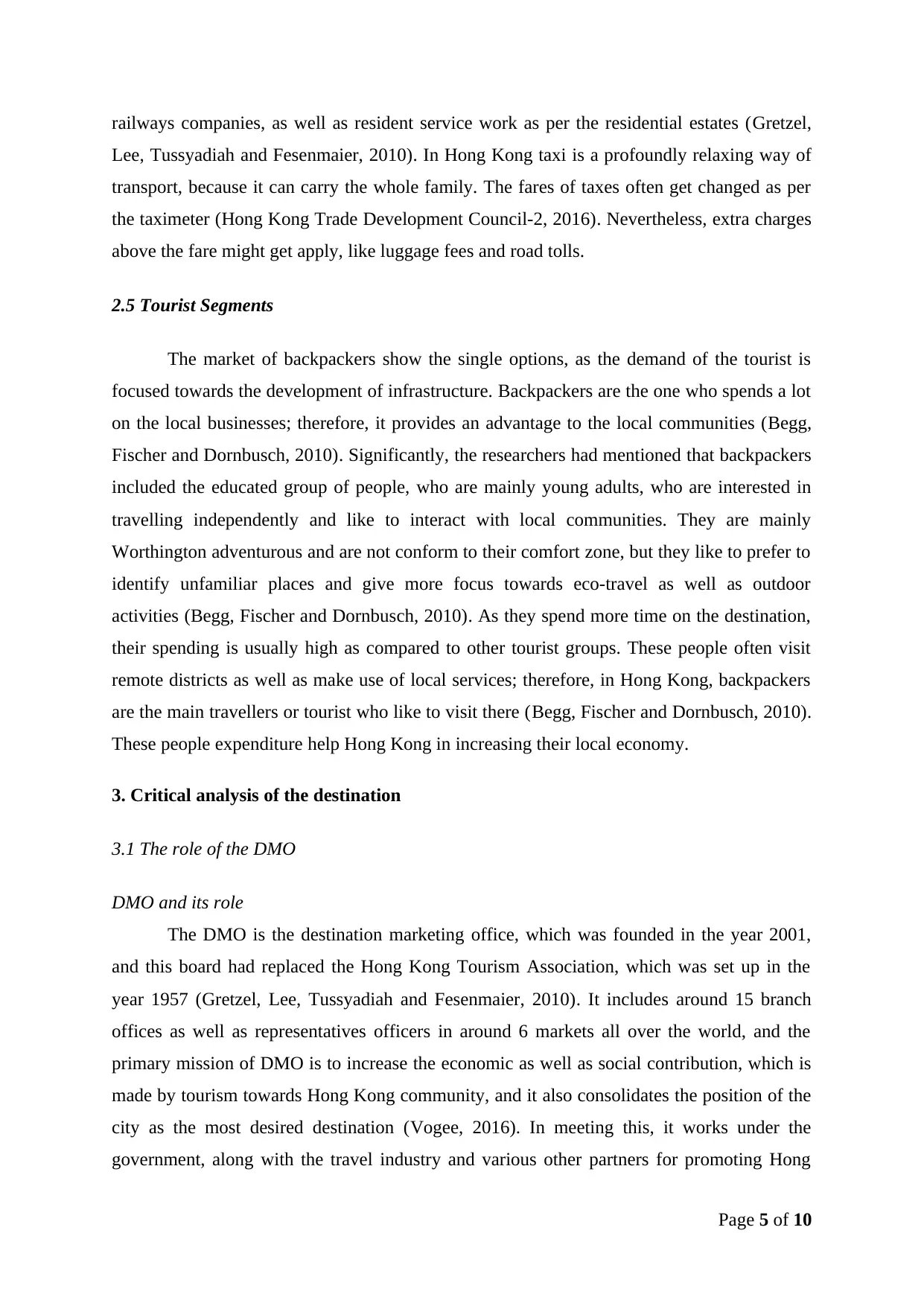
railways companies, as well as resident service work as per the residential estates (Gretzel,
Lee, Tussyadiah and Fesenmaier, 2010). In Hong Kong taxi is a profoundly relaxing way of
transport, because it can carry the whole family. The fares of taxes often get changed as per
the taximeter (Hong Kong Trade Development Council-2, 2016). Nevertheless, extra charges
above the fare might get apply, like luggage fees and road tolls.
2.5 Tourist Segments
The market of backpackers show the single options, as the demand of the tourist is
focused towards the development of infrastructure. Backpackers are the one who spends a lot
on the local businesses; therefore, it provides an advantage to the local communities (Begg,
Fischer and Dornbusch, 2010). Significantly, the researchers had mentioned that backpackers
included the educated group of people, who are mainly young adults, who are interested in
travelling independently and like to interact with local communities. They are mainly
Worthington adventurous and are not conform to their comfort zone, but they like to prefer to
identify unfamiliar places and give more focus towards eco-travel as well as outdoor
activities (Begg, Fischer and Dornbusch, 2010). As they spend more time on the destination,
their spending is usually high as compared to other tourist groups. These people often visit
remote districts as well as make use of local services; therefore, in Hong Kong, backpackers
are the main travellers or tourist who like to visit there (Begg, Fischer and Dornbusch, 2010).
These people expenditure help Hong Kong in increasing their local economy.
3. Critical analysis of the destination
3.1 The role of the DMO
DMO and its role
The DMO is the destination marketing office, which was founded in the year 2001,
and this board had replaced the Hong Kong Tourism Association, which was set up in the
year 1957 (Gretzel, Lee, Tussyadiah and Fesenmaier, 2010). It includes around 15 branch
offices as well as representatives officers in around 6 markets all over the world, and the
primary mission of DMO is to increase the economic as well as social contribution, which is
made by tourism towards Hong Kong community, and it also consolidates the position of the
city as the most desired destination (Vogee, 2016). In meeting this, it works under the
government, along with the travel industry and various other partners for promoting Hong
Page 5 of 10
Lee, Tussyadiah and Fesenmaier, 2010). In Hong Kong taxi is a profoundly relaxing way of
transport, because it can carry the whole family. The fares of taxes often get changed as per
the taximeter (Hong Kong Trade Development Council-2, 2016). Nevertheless, extra charges
above the fare might get apply, like luggage fees and road tolls.
2.5 Tourist Segments
The market of backpackers show the single options, as the demand of the tourist is
focused towards the development of infrastructure. Backpackers are the one who spends a lot
on the local businesses; therefore, it provides an advantage to the local communities (Begg,
Fischer and Dornbusch, 2010). Significantly, the researchers had mentioned that backpackers
included the educated group of people, who are mainly young adults, who are interested in
travelling independently and like to interact with local communities. They are mainly
Worthington adventurous and are not conform to their comfort zone, but they like to prefer to
identify unfamiliar places and give more focus towards eco-travel as well as outdoor
activities (Begg, Fischer and Dornbusch, 2010). As they spend more time on the destination,
their spending is usually high as compared to other tourist groups. These people often visit
remote districts as well as make use of local services; therefore, in Hong Kong, backpackers
are the main travellers or tourist who like to visit there (Begg, Fischer and Dornbusch, 2010).
These people expenditure help Hong Kong in increasing their local economy.
3. Critical analysis of the destination
3.1 The role of the DMO
DMO and its role
The DMO is the destination marketing office, which was founded in the year 2001,
and this board had replaced the Hong Kong Tourism Association, which was set up in the
year 1957 (Gretzel, Lee, Tussyadiah and Fesenmaier, 2010). It includes around 15 branch
offices as well as representatives officers in around 6 markets all over the world, and the
primary mission of DMO is to increase the economic as well as social contribution, which is
made by tourism towards Hong Kong community, and it also consolidates the position of the
city as the most desired destination (Vogee, 2016). In meeting this, it works under the
government, along with the travel industry and various other partners for promoting Hong
Page 5 of 10
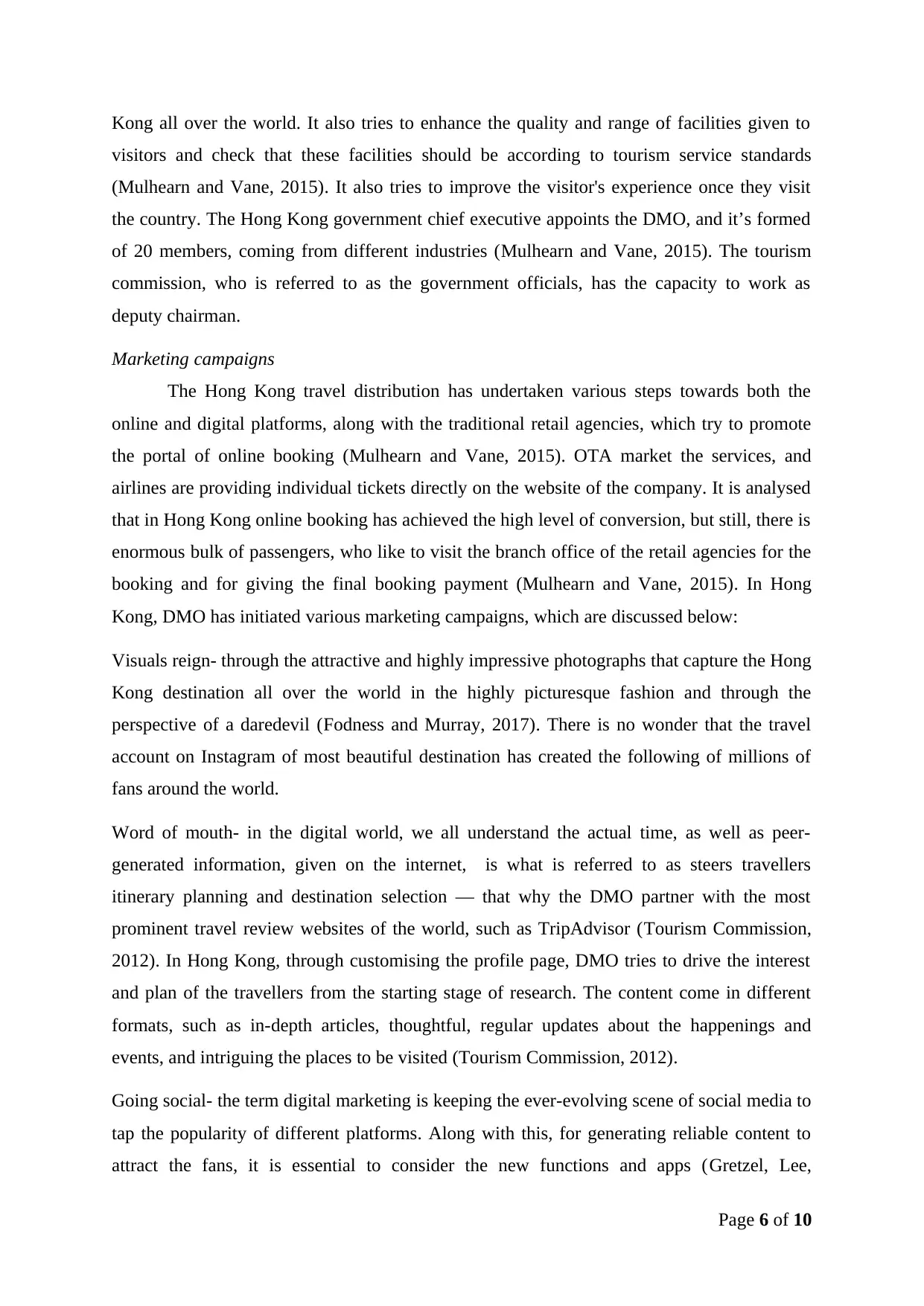
Kong all over the world. It also tries to enhance the quality and range of facilities given to
visitors and check that these facilities should be according to tourism service standards
(Mulhearn and Vane, 2015). It also tries to improve the visitor's experience once they visit
the country. The Hong Kong government chief executive appoints the DMO, and it’s formed
of 20 members, coming from different industries (Mulhearn and Vane, 2015). The tourism
commission, who is referred to as the government officials, has the capacity to work as
deputy chairman.
Marketing campaigns
The Hong Kong travel distribution has undertaken various steps towards both the
online and digital platforms, along with the traditional retail agencies, which try to promote
the portal of online booking (Mulhearn and Vane, 2015). OTA market the services, and
airlines are providing individual tickets directly on the website of the company. It is analysed
that in Hong Kong online booking has achieved the high level of conversion, but still, there is
enormous bulk of passengers, who like to visit the branch office of the retail agencies for the
booking and for giving the final booking payment (Mulhearn and Vane, 2015). In Hong
Kong, DMO has initiated various marketing campaigns, which are discussed below:
Visuals reign- through the attractive and highly impressive photographs that capture the Hong
Kong destination all over the world in the highly picturesque fashion and through the
perspective of a daredevil (Fodness and Murray, 2017). There is no wonder that the travel
account on Instagram of most beautiful destination has created the following of millions of
fans around the world.
Word of mouth- in the digital world, we all understand the actual time, as well as peer-
generated information, given on the internet, is what is referred to as steers travellers
itinerary planning and destination selection — that why the DMO partner with the most
prominent travel review websites of the world, such as TripAdvisor (Tourism Commission,
2012). In Hong Kong, through customising the profile page, DMO tries to drive the interest
and plan of the travellers from the starting stage of research. The content come in different
formats, such as in-depth articles, thoughtful, regular updates about the happenings and
events, and intriguing the places to be visited (Tourism Commission, 2012).
Going social- the term digital marketing is keeping the ever-evolving scene of social media to
tap the popularity of different platforms. Along with this, for generating reliable content to
attract the fans, it is essential to consider the new functions and apps (Gretzel, Lee,
Page 6 of 10
visitors and check that these facilities should be according to tourism service standards
(Mulhearn and Vane, 2015). It also tries to improve the visitor's experience once they visit
the country. The Hong Kong government chief executive appoints the DMO, and it’s formed
of 20 members, coming from different industries (Mulhearn and Vane, 2015). The tourism
commission, who is referred to as the government officials, has the capacity to work as
deputy chairman.
Marketing campaigns
The Hong Kong travel distribution has undertaken various steps towards both the
online and digital platforms, along with the traditional retail agencies, which try to promote
the portal of online booking (Mulhearn and Vane, 2015). OTA market the services, and
airlines are providing individual tickets directly on the website of the company. It is analysed
that in Hong Kong online booking has achieved the high level of conversion, but still, there is
enormous bulk of passengers, who like to visit the branch office of the retail agencies for the
booking and for giving the final booking payment (Mulhearn and Vane, 2015). In Hong
Kong, DMO has initiated various marketing campaigns, which are discussed below:
Visuals reign- through the attractive and highly impressive photographs that capture the Hong
Kong destination all over the world in the highly picturesque fashion and through the
perspective of a daredevil (Fodness and Murray, 2017). There is no wonder that the travel
account on Instagram of most beautiful destination has created the following of millions of
fans around the world.
Word of mouth- in the digital world, we all understand the actual time, as well as peer-
generated information, given on the internet, is what is referred to as steers travellers
itinerary planning and destination selection — that why the DMO partner with the most
prominent travel review websites of the world, such as TripAdvisor (Tourism Commission,
2012). In Hong Kong, through customising the profile page, DMO tries to drive the interest
and plan of the travellers from the starting stage of research. The content come in different
formats, such as in-depth articles, thoughtful, regular updates about the happenings and
events, and intriguing the places to be visited (Tourism Commission, 2012).
Going social- the term digital marketing is keeping the ever-evolving scene of social media to
tap the popularity of different platforms. Along with this, for generating reliable content to
attract the fans, it is essential to consider the new functions and apps (Gretzel, Lee,
Page 6 of 10
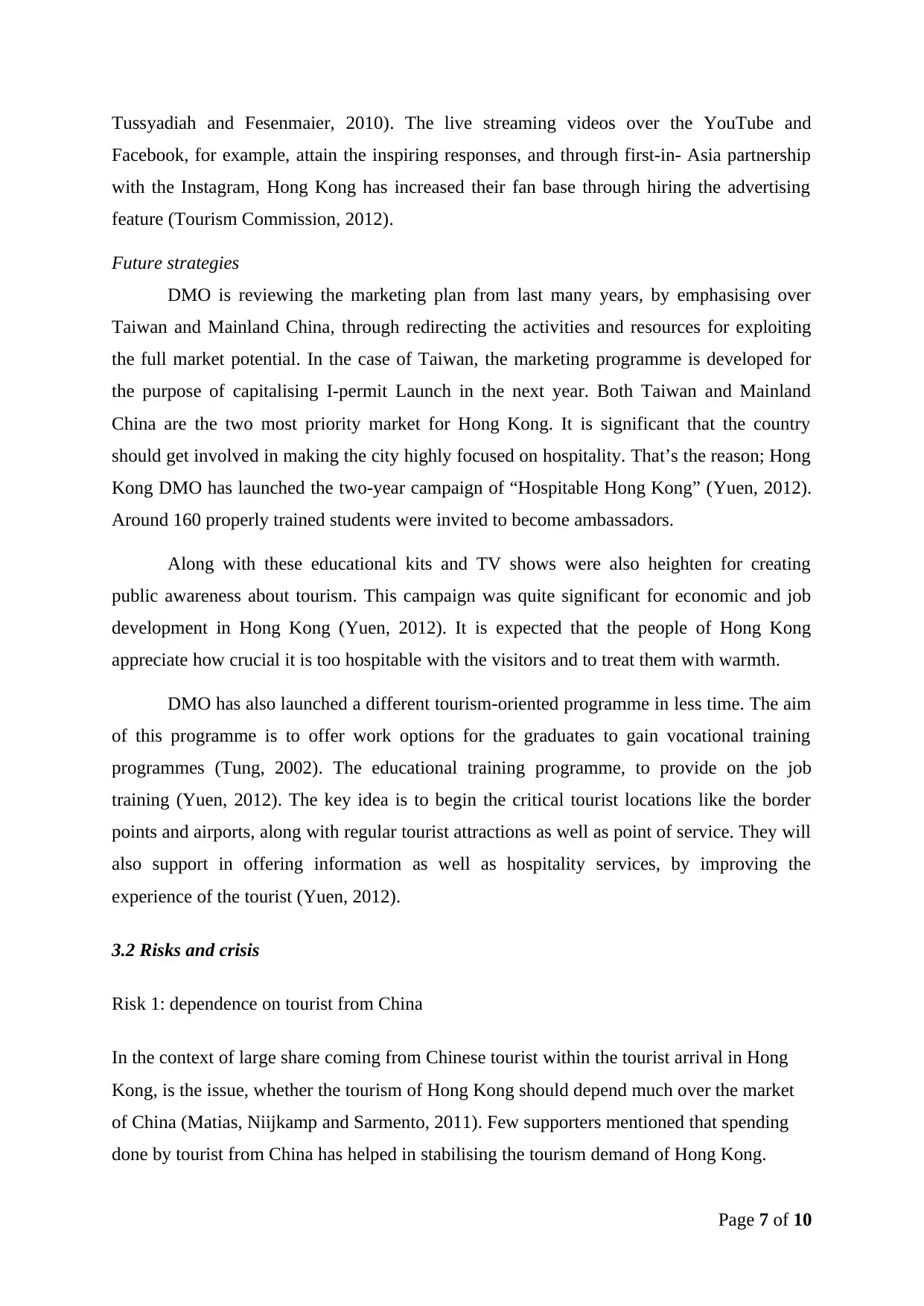
Tussyadiah and Fesenmaier, 2010). The live streaming videos over the YouTube and
Facebook, for example, attain the inspiring responses, and through first-in- Asia partnership
with the Instagram, Hong Kong has increased their fan base through hiring the advertising
feature (Tourism Commission, 2012).
Future strategies
DMO is reviewing the marketing plan from last many years, by emphasising over
Taiwan and Mainland China, through redirecting the activities and resources for exploiting
the full market potential. In the case of Taiwan, the marketing programme is developed for
the purpose of capitalising I-permit Launch in the next year. Both Taiwan and Mainland
China are the two most priority market for Hong Kong. It is significant that the country
should get involved in making the city highly focused on hospitality. That’s the reason; Hong
Kong DMO has launched the two-year campaign of “Hospitable Hong Kong” (Yuen, 2012).
Around 160 properly trained students were invited to become ambassadors.
Along with these educational kits and TV shows were also heighten for creating
public awareness about tourism. This campaign was quite significant for economic and job
development in Hong Kong (Yuen, 2012). It is expected that the people of Hong Kong
appreciate how crucial it is too hospitable with the visitors and to treat them with warmth.
DMO has also launched a different tourism-oriented programme in less time. The aim
of this programme is to offer work options for the graduates to gain vocational training
programmes (Tung, 2002). The educational training programme, to provide on the job
training (Yuen, 2012). The key idea is to begin the critical tourist locations like the border
points and airports, along with regular tourist attractions as well as point of service. They will
also support in offering information as well as hospitality services, by improving the
experience of the tourist (Yuen, 2012).
3.2 Risks and crisis
Risk 1: dependence on tourist from China
In the context of large share coming from Chinese tourist within the tourist arrival in Hong
Kong, is the issue, whether the tourism of Hong Kong should depend much over the market
of China (Matias, Niijkamp and Sarmento, 2011). Few supporters mentioned that spending
done by tourist from China has helped in stabilising the tourism demand of Hong Kong.
Page 7 of 10
Facebook, for example, attain the inspiring responses, and through first-in- Asia partnership
with the Instagram, Hong Kong has increased their fan base through hiring the advertising
feature (Tourism Commission, 2012).
Future strategies
DMO is reviewing the marketing plan from last many years, by emphasising over
Taiwan and Mainland China, through redirecting the activities and resources for exploiting
the full market potential. In the case of Taiwan, the marketing programme is developed for
the purpose of capitalising I-permit Launch in the next year. Both Taiwan and Mainland
China are the two most priority market for Hong Kong. It is significant that the country
should get involved in making the city highly focused on hospitality. That’s the reason; Hong
Kong DMO has launched the two-year campaign of “Hospitable Hong Kong” (Yuen, 2012).
Around 160 properly trained students were invited to become ambassadors.
Along with these educational kits and TV shows were also heighten for creating
public awareness about tourism. This campaign was quite significant for economic and job
development in Hong Kong (Yuen, 2012). It is expected that the people of Hong Kong
appreciate how crucial it is too hospitable with the visitors and to treat them with warmth.
DMO has also launched a different tourism-oriented programme in less time. The aim
of this programme is to offer work options for the graduates to gain vocational training
programmes (Tung, 2002). The educational training programme, to provide on the job
training (Yuen, 2012). The key idea is to begin the critical tourist locations like the border
points and airports, along with regular tourist attractions as well as point of service. They will
also support in offering information as well as hospitality services, by improving the
experience of the tourist (Yuen, 2012).
3.2 Risks and crisis
Risk 1: dependence on tourist from China
In the context of large share coming from Chinese tourist within the tourist arrival in Hong
Kong, is the issue, whether the tourism of Hong Kong should depend much over the market
of China (Matias, Niijkamp and Sarmento, 2011). Few supporters mentioned that spending
done by tourist from China has helped in stabilising the tourism demand of Hong Kong.
Page 7 of 10
Paraphrase This Document
Need a fresh take? Get an instant paraphrase of this document with our AI Paraphraser
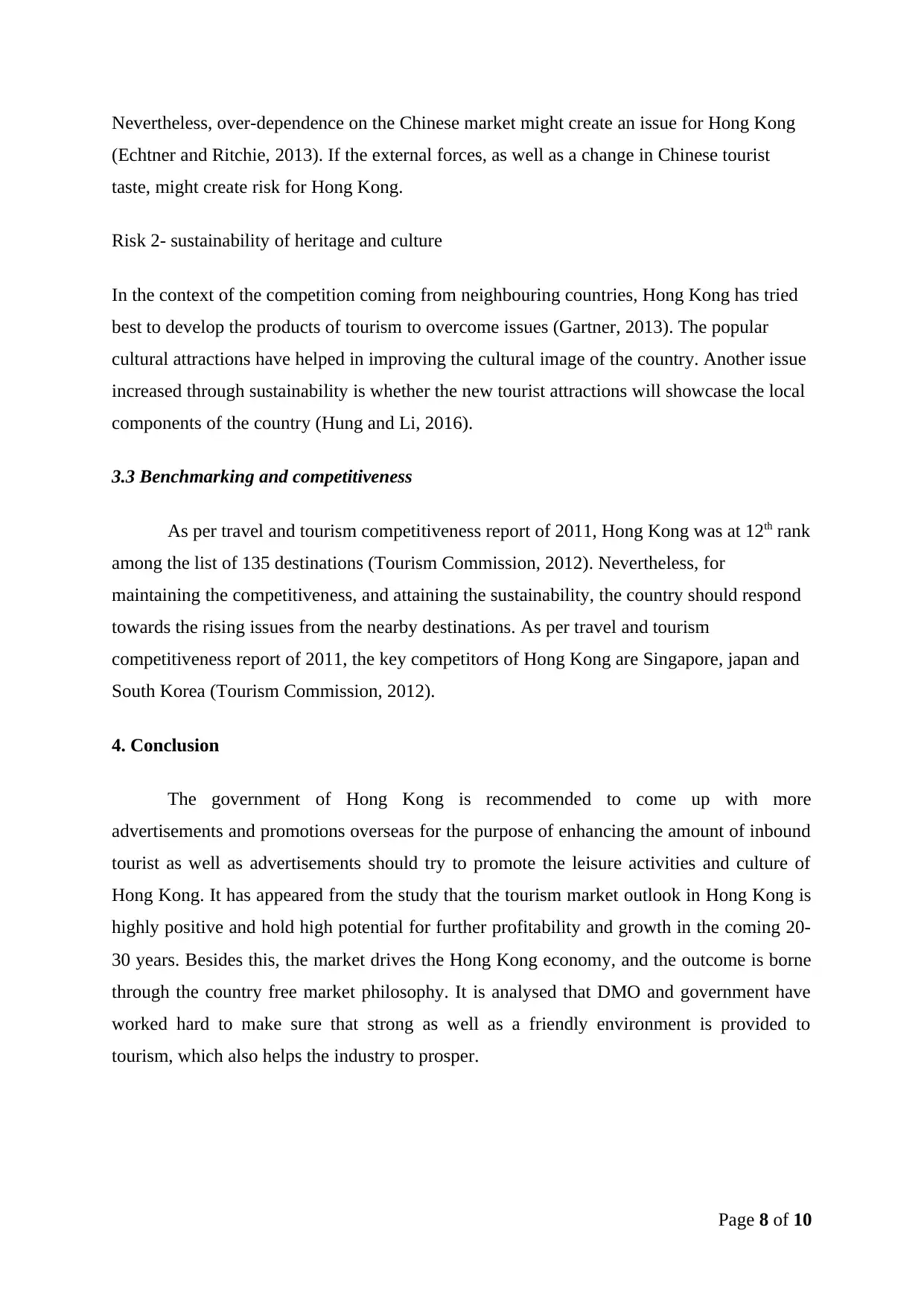
Nevertheless, over-dependence on the Chinese market might create an issue for Hong Kong
(Echtner and Ritchie, 2013). If the external forces, as well as a change in Chinese tourist
taste, might create risk for Hong Kong.
Risk 2- sustainability of heritage and culture
In the context of the competition coming from neighbouring countries, Hong Kong has tried
best to develop the products of tourism to overcome issues (Gartner, 2013). The popular
cultural attractions have helped in improving the cultural image of the country. Another issue
increased through sustainability is whether the new tourist attractions will showcase the local
components of the country (Hung and Li, 2016).
3.3 Benchmarking and competitiveness
As per travel and tourism competitiveness report of 2011, Hong Kong was at 12th rank
among the list of 135 destinations (Tourism Commission, 2012). Nevertheless, for
maintaining the competitiveness, and attaining the sustainability, the country should respond
towards the rising issues from the nearby destinations. As per travel and tourism
competitiveness report of 2011, the key competitors of Hong Kong are Singapore, japan and
South Korea (Tourism Commission, 2012).
4. Conclusion
The government of Hong Kong is recommended to come up with more
advertisements and promotions overseas for the purpose of enhancing the amount of inbound
tourist as well as advertisements should try to promote the leisure activities and culture of
Hong Kong. It has appeared from the study that the tourism market outlook in Hong Kong is
highly positive and hold high potential for further profitability and growth in the coming 20-
30 years. Besides this, the market drives the Hong Kong economy, and the outcome is borne
through the country free market philosophy. It is analysed that DMO and government have
worked hard to make sure that strong as well as a friendly environment is provided to
tourism, which also helps the industry to prosper.
Page 8 of 10
(Echtner and Ritchie, 2013). If the external forces, as well as a change in Chinese tourist
taste, might create risk for Hong Kong.
Risk 2- sustainability of heritage and culture
In the context of the competition coming from neighbouring countries, Hong Kong has tried
best to develop the products of tourism to overcome issues (Gartner, 2013). The popular
cultural attractions have helped in improving the cultural image of the country. Another issue
increased through sustainability is whether the new tourist attractions will showcase the local
components of the country (Hung and Li, 2016).
3.3 Benchmarking and competitiveness
As per travel and tourism competitiveness report of 2011, Hong Kong was at 12th rank
among the list of 135 destinations (Tourism Commission, 2012). Nevertheless, for
maintaining the competitiveness, and attaining the sustainability, the country should respond
towards the rising issues from the nearby destinations. As per travel and tourism
competitiveness report of 2011, the key competitors of Hong Kong are Singapore, japan and
South Korea (Tourism Commission, 2012).
4. Conclusion
The government of Hong Kong is recommended to come up with more
advertisements and promotions overseas for the purpose of enhancing the amount of inbound
tourist as well as advertisements should try to promote the leisure activities and culture of
Hong Kong. It has appeared from the study that the tourism market outlook in Hong Kong is
highly positive and hold high potential for further profitability and growth in the coming 20-
30 years. Besides this, the market drives the Hong Kong economy, and the outcome is borne
through the country free market philosophy. It is analysed that DMO and government have
worked hard to make sure that strong as well as a friendly environment is provided to
tourism, which also helps the industry to prosper.
Page 8 of 10
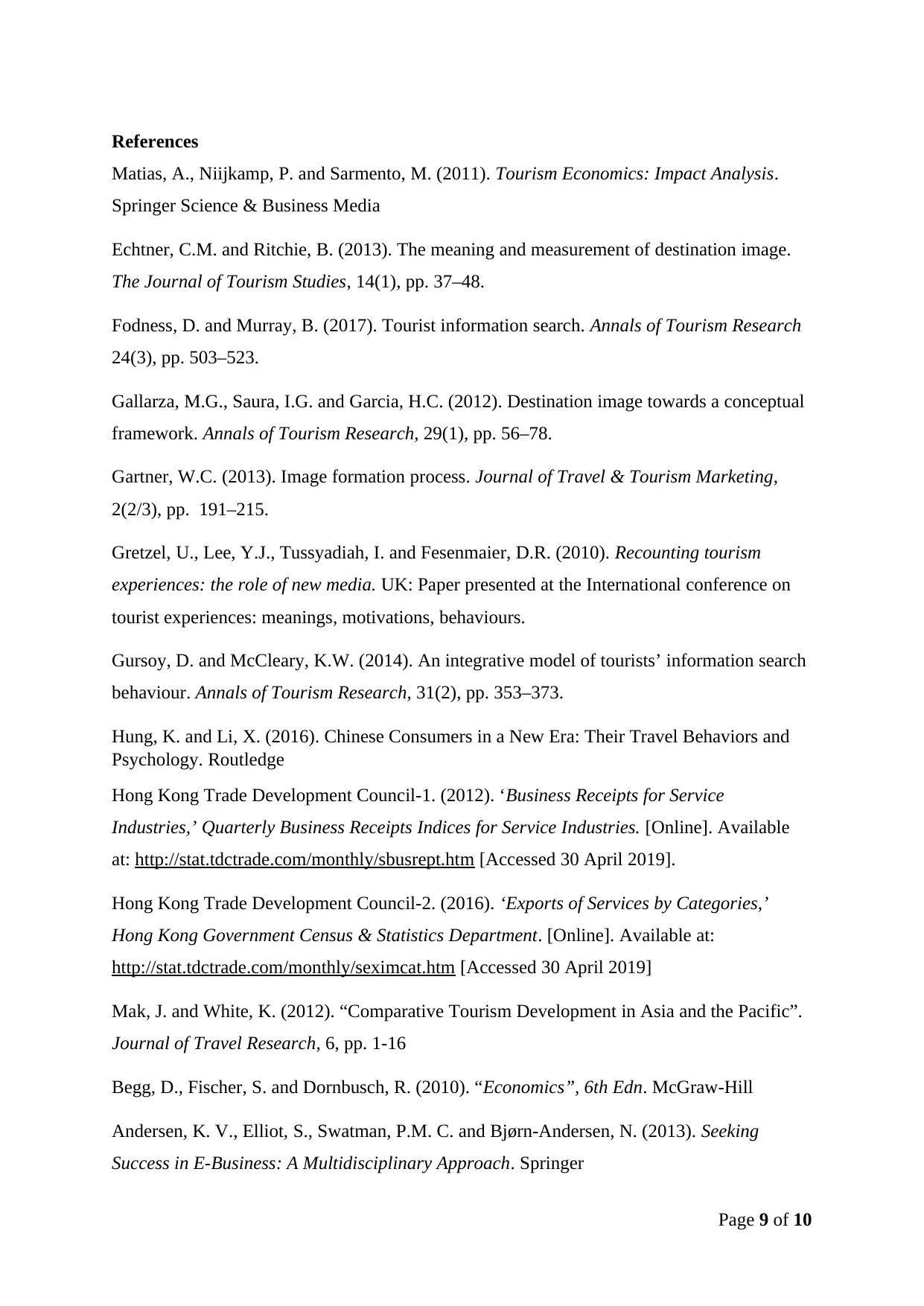
References
Matias, A., Niijkamp, P. and Sarmento, M. (2011). Tourism Economics: Impact Analysis.
Springer Science & Business Media
Echtner, C.M. and Ritchie, B. (2013). The meaning and measurement of destination image.
The Journal of Tourism Studies, 14(1), pp. 37–48.
Fodness, D. and Murray, B. (2017). Tourist information search. Annals of Tourism Research
24(3), pp. 503–523.
Gallarza, M.G., Saura, I.G. and Garcia, H.C. (2012). Destination image towards a conceptual
framework. Annals of Tourism Research, 29(1), pp. 56–78.
Gartner, W.C. (2013). Image formation process. Journal of Travel & Tourism Marketing,
2(2/3), pp. 191–215.
Gretzel, U., Lee, Y.J., Tussyadiah, I. and Fesenmaier, D.R. (2010). Recounting tourism
experiences: the role of new media. UK: Paper presented at the International conference on
tourist experiences: meanings, motivations, behaviours.
Gursoy, D. and McCleary, K.W. (2014). An integrative model of tourists’ information search
behaviour. Annals of Tourism Research, 31(2), pp. 353–373.
Hung, K. and Li, X. (2016). Chinese Consumers in a New Era: Their Travel Behaviors and
Psychology. Routledge
Hong Kong Trade Development Council-1. (2012). ‘Business Receipts for Service
Industries,’ Quarterly Business Receipts Indices for Service Industries. [Online]. Available
at: http://stat.tdctrade.com/monthly/sbusrept.htm [Accessed 30 April 2019].
Hong Kong Trade Development Council-2. (2016). ‘Exports of Services by Categories,’
Hong Kong Government Census & Statistics Department. [Online]. Available at:
http://stat.tdctrade.com/monthly/seximcat.htm [Accessed 30 April 2019]
Mak, J. and White, K. (2012). “Comparative Tourism Development in Asia and the Pacific”.
Journal of Travel Research, 6, pp. 1-16
Begg, D., Fischer, S. and Dornbusch, R. (2010). “Economics”, 6th Edn. McGraw-Hill
Andersen, K. V., Elliot, S., Swatman, P.M. C. and Bjørn-Andersen, N. (2013). Seeking
Success in E-Business: A Multidisciplinary Approach. Springer
Page 9 of 10
Matias, A., Niijkamp, P. and Sarmento, M. (2011). Tourism Economics: Impact Analysis.
Springer Science & Business Media
Echtner, C.M. and Ritchie, B. (2013). The meaning and measurement of destination image.
The Journal of Tourism Studies, 14(1), pp. 37–48.
Fodness, D. and Murray, B. (2017). Tourist information search. Annals of Tourism Research
24(3), pp. 503–523.
Gallarza, M.G., Saura, I.G. and Garcia, H.C. (2012). Destination image towards a conceptual
framework. Annals of Tourism Research, 29(1), pp. 56–78.
Gartner, W.C. (2013). Image formation process. Journal of Travel & Tourism Marketing,
2(2/3), pp. 191–215.
Gretzel, U., Lee, Y.J., Tussyadiah, I. and Fesenmaier, D.R. (2010). Recounting tourism
experiences: the role of new media. UK: Paper presented at the International conference on
tourist experiences: meanings, motivations, behaviours.
Gursoy, D. and McCleary, K.W. (2014). An integrative model of tourists’ information search
behaviour. Annals of Tourism Research, 31(2), pp. 353–373.
Hung, K. and Li, X. (2016). Chinese Consumers in a New Era: Their Travel Behaviors and
Psychology. Routledge
Hong Kong Trade Development Council-1. (2012). ‘Business Receipts for Service
Industries,’ Quarterly Business Receipts Indices for Service Industries. [Online]. Available
at: http://stat.tdctrade.com/monthly/sbusrept.htm [Accessed 30 April 2019].
Hong Kong Trade Development Council-2. (2016). ‘Exports of Services by Categories,’
Hong Kong Government Census & Statistics Department. [Online]. Available at:
http://stat.tdctrade.com/monthly/seximcat.htm [Accessed 30 April 2019]
Mak, J. and White, K. (2012). “Comparative Tourism Development in Asia and the Pacific”.
Journal of Travel Research, 6, pp. 1-16
Begg, D., Fischer, S. and Dornbusch, R. (2010). “Economics”, 6th Edn. McGraw-Hill
Andersen, K. V., Elliot, S., Swatman, P.M. C. and Bjørn-Andersen, N. (2013). Seeking
Success in E-Business: A Multidisciplinary Approach. Springer
Page 9 of 10
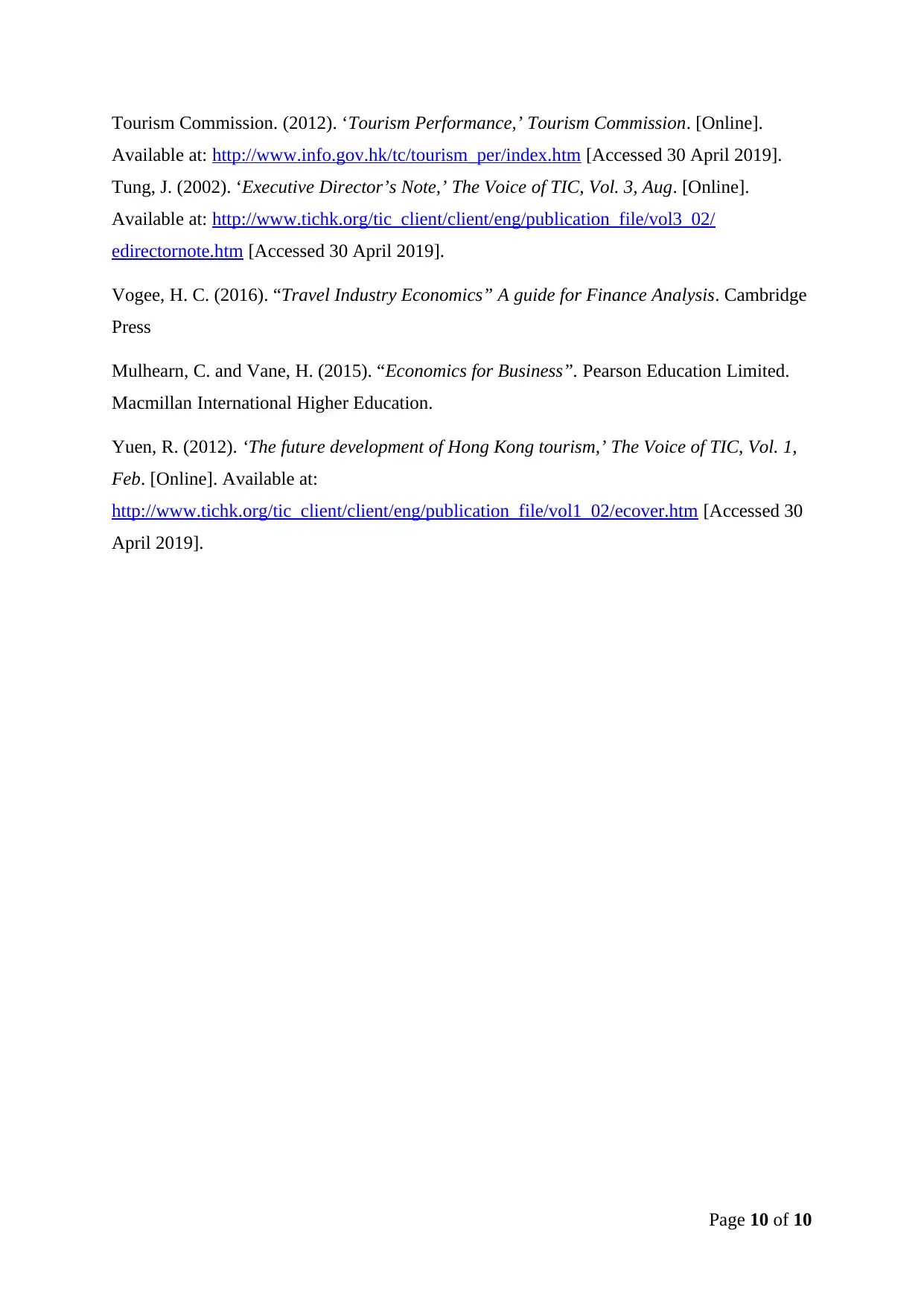
Tourism Commission. (2012). ‘Tourism Performance,’ Tourism Commission. [Online].
Available at: http://www.info.gov.hk/tc/tourism_per/index.htm [Accessed 30 April 2019].
Tung, J. (2002). ‘Executive Director’s Note,’ The Voice of TIC, Vol. 3, Aug. [Online].
Available at: http://www.tichk.org/tic_client/client/eng/publication_file/vol3_02/
edirectornote.htm [Accessed 30 April 2019].
Vogee, H. C. (2016). “Travel Industry Economics” A guide for Finance Analysis. Cambridge
Press
Mulhearn, C. and Vane, H. (2015). “Economics for Business”. Pearson Education Limited.
Macmillan International Higher Education.
Yuen, R. (2012). ‘The future development of Hong Kong tourism,’ The Voice of TIC, Vol. 1,
Feb. [Online]. Available at:
http://www.tichk.org/tic_client/client/eng/publication_file/vol1_02/ecover.htm [Accessed 30
April 2019].
Page 10 of 10
Available at: http://www.info.gov.hk/tc/tourism_per/index.htm [Accessed 30 April 2019].
Tung, J. (2002). ‘Executive Director’s Note,’ The Voice of TIC, Vol. 3, Aug. [Online].
Available at: http://www.tichk.org/tic_client/client/eng/publication_file/vol3_02/
edirectornote.htm [Accessed 30 April 2019].
Vogee, H. C. (2016). “Travel Industry Economics” A guide for Finance Analysis. Cambridge
Press
Mulhearn, C. and Vane, H. (2015). “Economics for Business”. Pearson Education Limited.
Macmillan International Higher Education.
Yuen, R. (2012). ‘The future development of Hong Kong tourism,’ The Voice of TIC, Vol. 1,
Feb. [Online]. Available at:
http://www.tichk.org/tic_client/client/eng/publication_file/vol1_02/ecover.htm [Accessed 30
April 2019].
Page 10 of 10
1 out of 10
Related Documents
Your All-in-One AI-Powered Toolkit for Academic Success.
+13062052269
info@desklib.com
Available 24*7 on WhatsApp / Email
![[object Object]](/_next/static/media/star-bottom.7253800d.svg)
Unlock your academic potential
© 2024 | Zucol Services PVT LTD | All rights reserved.





